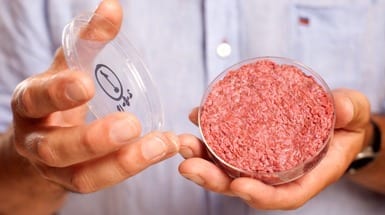
For the first time, the public has been treated to the spectacle of lab-grown meat cooked and eaten via live Webcast.
Backed by Google billionaire Sergey Brin, Dutch tissue engineer Mark Post unveiled his “cultured beef” at a press event on August 5, answering the question posed by a 2011 Scientific American feature: “When Will Scientists Grow Meat in a Petri Dish?”
The verdict? “It is close to meat,” said nutrition scientist Hanni Rutzler. “It is not that juicy.” But British chef Richard McGeowan said the lack of fat didn’t affect his cooking of the five ounces of minced “meat” in a frying pan, thanks to lots of butter.
In addition to a lack of fat with the meat (tissue biologists just haven’t gotten that union down yet), the in vitro meat features heavy antibiotic use to keep the cells alive and growth on serum from the blood of unborn cows gathered from slaughterhouses (as well as the less gruesome sugars, proteins and fatty acids). As synthetic biologist Christina Agapakis noted in a blog critique in 2012: “Cell culture is one of the most expensive and resource-intensive techniques in modern biology.”
Then the meat requires “exercise” on a scaffold. There are questions about its nutritional value as well, such as how much iron it might contain compared with traditional meat. The lab meat has to be colored red after all, by adding beet juice because it is composed of 20,000 or so thin strips of muscle cells rather than the complicated mélange of muscle, fat, blood vessels and bone found in meat from an animal.
Despite all this, the lab beef is being cultured (and feted) because of its potential to reduce the environmental impacts of the human taste for meat. As Post notes, the U.N. Food and Agriculture Organization estimates that demand for meat will swell by more than 70 percent by 2050. Already 30 percent of the world’s ice-free land is devoted to feeding animals for meat thanks to the fact that cows and pigs convert only roughly 15 percent of the plants they eat into edible meat. Then there’s the problem of the greenhouse gas emissions, particularly potent methane, from all those ruminant belches and their waste, often stored in massive, stinky lagoons. The FAO estimates that livestock are responsible for nearly 20 percent of all greenhouse gas emissions from human activities—more than all cars, trucks, ships and airplanes put together.
Of course, to reduce those emissions, the lab meat would have to be grown on a diet of algae, something that has never been accomplished. If that can be done on a big scale (and that’s a big if), the lab meat would reduce methane pollution by 95 percent, as well as reduce the need for farmlands to feed livestock by 98 percent, according to a 2011 study by the University of Oxford published in Environmental Science and Technology. Or we could just eat the algae directly.
The other reason for the hoopla is ethical: philosopher Peter Singer and groups such as People for the Ethical Treatment of Animals extol such efforts for eliminating human cruelty to animals. Why not harvest muscle cells from a single cow to culture millions of hamburgers rather than slaughtering hundreds of thousands of cattle?
The Latest Bing News on:
Cultured Beef
- Florida’s ban on cultivated meat sacrifices conservative principles for culture war pointson May 9, 2024 at 5:56 pm
It is not yet clear whether the alternative protein products known variously as “lab-grown,” “cell-cultivated” or “cultured” meat will deliver the environmental ...
- Florida’s cultured meat ban is dumb. But it can have big consequenceson May 9, 2024 at 1:51 pm
Florida became the first state to outlaw lab-grown meat last week. It was basically a handout to the agri business mixed with a bit of conspiracy theory peddling. State Rep. Dean Black, a Republican ...
- Why Ron DeSantis and John Fetterman Are Beefing with Lab-Grown Meaton May 9, 2024 at 11:45 am
Republican lawmakers from agriculture-heavy states (e.g., Alabama, Arizona, Tennessee) have targeted cultivated beef as another red-meat culture war issue, debating legislative restrictions on ...
- DeSantis vs. Jeff Bezos? Lab-grown meat ban bucks billionaire’s investmenton May 9, 2024 at 10:22 am
Ron DeSantis start a beef with one of Florida's newest ... How is it made? Also referred to as "cultured meat" or "cultivated meat," lab-grown meat is a meat alternative made from animal stem cells.
- MIT Technology Reviewon May 7, 2024 at 6:25 am
Let’s stop inventing reasons to reject cultured meat and other protein alternatives that could dramatically cut climate emissions.
- Meat, Freedom and Ron DeSantison May 6, 2024 at 4:00 pm
Still, if and when lab-grown meat, also sometimes referred to as cultured meat, makes it onto the market at less than outrageous prices, a significant number of people will probably buy it. Some will ...
- The cultured wars: Why lab-grown meat is inspiring bipartisan hateon May 6, 2024 at 11:00 am
This is something the governor of Florida — a Republican who was previously, and perhaps fittingly, dubbed “Meatball Ron” by former president Donald Trump — has made clear for months, first while ...
- Florida’s ban on lab-grown meat: How does it differ from ‘Impossible,’ vegan substitutes?on May 6, 2024 at 8:58 am
Ron DeSantis started a beef with lab-grown meat ... What is lab-grown meat and how is it made? Also referred to as "cultured meat" or "cultivated meat," lab-grown meat is a meat alternative made from ...
- Florida bans lab-grown meat. Have any other states passed their own bans against it?on May 6, 2024 at 8:40 am
Which other states are cooking up anti-cultivated meat legislation along with Florida? Here's what to know, why DeSantis is banning lab-grown meat.
- Florida bans lab-grown meat as other states weigh it: What's their beef with cultured meat?on May 5, 2024 at 4:02 am
Florida Gov. Ron DeSantis signed into law this week a ban prohibiting the manufacture and distribution of lab-grown meat in the state.
The Latest Google Headlines on:
Cultured Beef
[google_news title=”” keyword=”Cultured Beef” num_posts=”10″ blurb_length=”0″ show_thumb=”left”]
The Latest Bing News on:
Lab-grown meat
- Why Ron DeSantis and John Fetterman Are Beefing with Lab-Grown Meaton May 9, 2024 at 11:45 am
Republican lawmakers from agriculture-heavy states (e.g., Alabama, Arizona, Tennessee) have targeted cultivated beef as another red-meat culture war issue, debating legislative restrictions on ...
- DeSantis vs. Jeff Bezos? Lab-grown meat ban bucks billionaire’s investmenton May 9, 2024 at 9:20 am
New Florida resident Jeff Bezos invested millions into cultivated meat earlier this year. One problem - DeSantis just banned it. Here's what to know.
- Sell Lab-Grown Meat in Alabama and You Could Go to Jailon May 9, 2024 at 8:49 am
Anyone found guilty of selling or manufacturing cultivated meat in Alabama will face up to a three-month jail sentence and $500 fine.
- Meatless in Miami? Eat Just's Founder Chews on Florida's Lab-Grown Meat Banon May 8, 2024 at 2:50 am
Good morning. If you're in Florida and are in search of a meatless option while you're in the Sunshine State, it just became harder to access alternative sources of protein. Florida governor Ron ...
- In budding battle over lab-grown meat, Florida takes opening stabon May 8, 2024 at 1:00 am
Cultured meat, meet culture war. The first rhetorical shots have just been fired in a political battle that could last years.The catalyst: lab-grown meat.Florida this month became the first U.S. state ...
- Jeff Bezos moved to Fla. and invested $60M into lab-grown meat — then Ron DeSantis banned iton May 6, 2024 at 9:53 am
Gov. Ron DeSantis barred the sale of lab-grown meat in the Sunshine State on May 1, calling it “the global elite’s plan to force the world to eat meat grown in a petri dish.” ...
- Florida’s ban on lab-grown meat: How does it differ from ‘Impossible,’ vegan substitutes?on May 6, 2024 at 7:59 am
DeSantis signed a bill that would outlaw the manufacture and distribution of lab-grown meat in the state. But will vegan options be banned too?
- Florida bans lab-grown meat. Have any other states passed their own bans against it?on May 6, 2024 at 6:50 am
Which other states are cooking up anti-cultivated meat legislation along with Florida? Here's what to know, why DeSantis is banning lab-grown meat.
- What is lab-grown meat, and why did Governor Ron DeSantis ban it in Florida?on May 4, 2024 at 10:30 am
Florida Governor Ron DeSantis said he wants to "save our beef" by signing a ban on the manufacture and distribution of lab-grown meat in the state.
- Lab-Grown Meat Company Says Ron DeSantis Ignoring Republican 'Basic Values'on May 4, 2024 at 9:34 am
Florida Governor Ron DeSantis has been accused of ignoring Republican "basic values" after he signed a law banning lab-grown meat, also known as cultured meat, throughout his state this week.
The Latest Google Headlines on:
Lab-grown meat
[google_news title=”” keyword=”lab-grown meat” num_posts=”10″ blurb_length=”0″ show_thumb=”left”]









